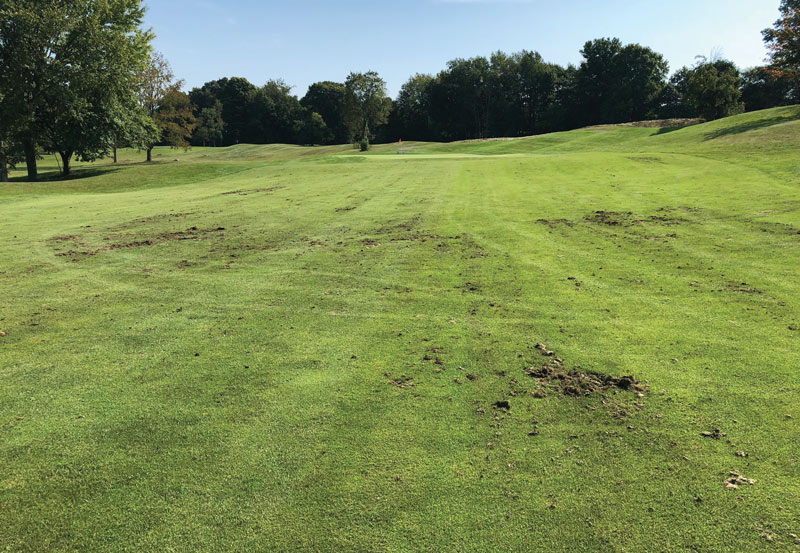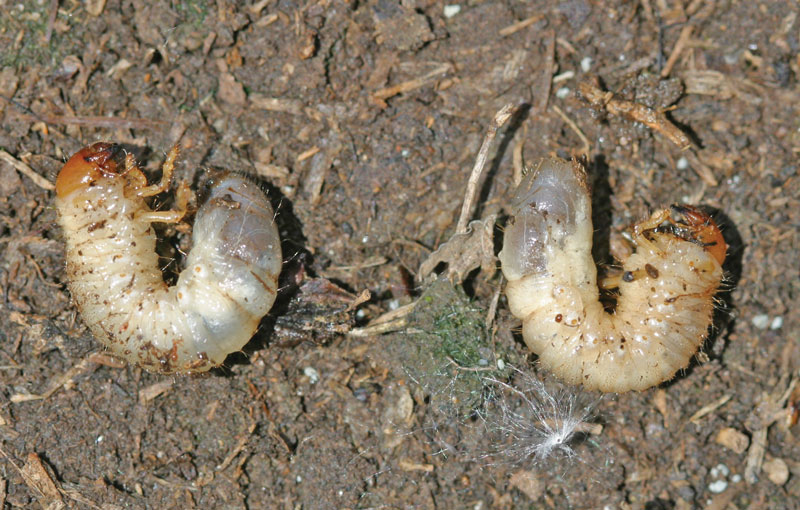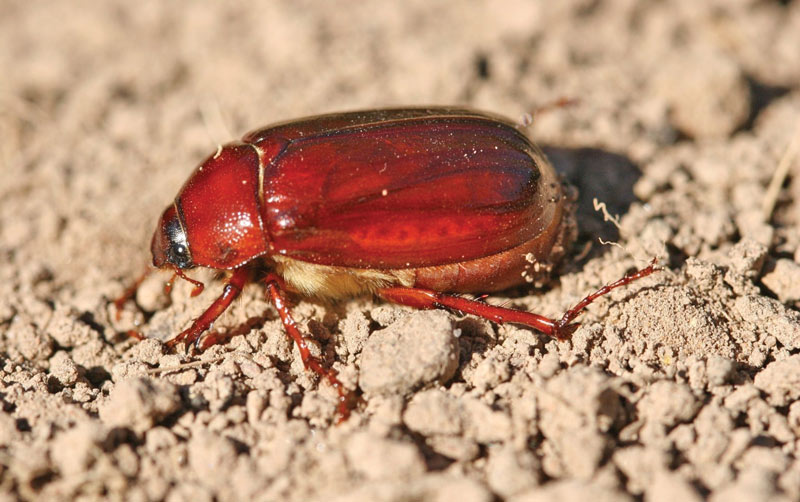
Turfgrass damage caused by white grubs and the mammals that prey on them. Photo by Ben McGraw
Editor’s note: The following article first appeared in the December 1995 issue of GCM. Because of its timeless insights for turf managers, we’ve dusted it off and are presenting it anew.
The severity and frequency of insect pest attacks on golf course turf vary considerably across the United States. In fact, the most troublesome insect species may vary from one area to the next. There is, however, one point of consistency regarding turf insect pest problems: The insects that cause the greatest frustration are those that live and feed in the soil.
In this article, these insects will be referred to as “subsurface pests” — those that feed on the roots of grasses. White grubs are the most common, and virtually all turf is vulnerable to attack from one or more species of them. Mole crickets are another serious subsurface pest, but they are more restricted in their geographical range. Other insect pests such as sod webworms and billbugs are considered soil insect pests by some because they live in the thatch or soil. However, sod webworms feed aboveground, and billbug larvae often feed on stems as well as roots and stolons.
Dealing with subsurface insect pests can be frustrating for several reasons. First, they may not be readily observed because they spend much of their lives in the soil, and digging may be required to find them. Second, the damage they cause can often be misdiagnosed (i.e., as drought stress). Finally, they’re often more difficult to control, because pesticides must be moved down into the soil to be in close proximity to the insect. In addition, some soil pests, such as Japanese beetle grubs, also cause problems in the adult stage by feeding on various ornamentals.
What follows is a review of several major subsurface pests, their biology, and the techniques that may help improve management of them. It is important to remember that these are general rules or philosophies that can lend an understanding of these pests. However, individual situations call for local expertise to refine particular management programs, so always refer to state recommendations for site-specific advice.
White grubs
The largest group of subsurface insect pests are white grubs. These are the larval or immature stage of certain beetles. Most of these grubs have a C-shaped appearance and are often referred to as “scarab grubs.” They can be found throughout the United States, but they’re most severe east of the Rocky Mountains. Southern turfgrasses are not attacked as frequently, but high maintenance and short cutting heights increase the likelihood of attack.
White grubs feed on the soil’s organic matter, including plant roots, and as a result, the most frequently observed damage symptoms mimic drought stress. The turf turns off-color and wilts, and when there is severe feeding and lack of soil moisture, it will die, often in irregular-shaped patches. In addition, the turf may feel “spongy” when walked on and can often be rolled back from the soil. Even light infestations can result in serious damage from skunks, moles, raccoons and other animals digging up the turf in search of food.

The underground nature of white grubs and other soil insects makes detection tougher than it is for surface feeders. Photo by Tom Royer
White grub life cycles are similar in that they all start out as an egg, hatch into a larva (grub), and complete development as an adult (beetle). White grub life cycles differ in that some species complete their development in one year, while others take two or three years to develop. Still others may have two or three generations in a single year. In general, many of the most damaging species have an annual life cycle, including the Japanese beetle and masked chafer. Most of these pests overwinter as larvae, but the black turfgrass ataenius overwinters as an adult.
Editor’s note: Taking a soil sample is the best way to scout for white grubs and other insects that feed on turf roots. A turf entomologist details the technique and several other insect-monitoring strategies in Turf insects: Looking for bugs in all the right places.
As with the management of any pest, proper identification is important. Because the grubs are the most damaging on turf, identification at this stage is critical. Most of the common damaging species can be identified with the aid of a hand magnifying lens. The following descriptions outline some of the differences and similarities among grubs. Although this list does not include all of them, it gives an overview of several important species.
Annual white grubs
Northern masked chafers are commonly found throughout the northeastern United States across to Illinois, and they most often damage Kentucky bluegrass. Northern masked chafers have a typical annual grub life cycle. The adults emerge from the soil in June and lay eggs in July. The grubs hatch in about three weeks and feed on roots until the soil cools in the fall, when they migrate downward in the soil. In spring, they move back near the soil surface to continue feeding, and in late May and early June, the grubs pupate to form adults. Thus, grub feeding damage can occur in both spring and fall. Heavy infestations turn the grass off-color, and it may die in irregular patches because of water stress.
Southern masked chafers are similar in appearance, life cycle and damage. Their distribution is a little different from that of the northern masked chafer. Southern masked chafers are commonly found from Pennsylvania to Kansas and in areas to the south. In the transition zone, they feed on Kentucky bluegrass and quite often on tall fescue, and in southern areas, they typically feed on bermudagrass.
Throughout the eastern third of the United States, from Wisconsin to Alabama and in a few isolated locations west of the Mississippi River, Japanese beetle grubs have become a serious and consistent problem for many superintendents. The problem is further enhanced because the adults, unlike the masked chafers, are also serious pests of various ornamentals. Though their damage and life cycle are similar to the masked chafer’s, Japanese beetle grubs frequently attack a wider range of turfgrasses, preferring to lay eggs in Kentucky bluegrass, perennial ryegrass, tall fescue and bentgrass.
Green June beetle grubs have also become an increasing problem in many areas. They can be found from Pennsylvania to Oklahoma and in areas to the south. Green June beetle grubs have been a particular problem in Kentucky, Tennessee, Maryland, Virginia and the Carolinas. The adults are large, metallic green beetles that feed on some foliage but prefer foods such as peaches, ears of corn and stalks of sorghum. These grubs are somewhat different from most others because they feed on organic matter and occasionally on turf roots, causing damage severe enough to result in turf death. More important, this grub feeds near the soil surface at night and creates unsightly mounds and tunnels that cause the soil to dry out rapidly. The grubs are most common in soils with a high organic matter content, which may be enhanced by the use of organic fertilizers and manures. These grubs also have one-year life cycles, but they are likely to become more active than other grubs and feed during the fall and early spring as temperatures rise.
Grubs with two or three generations per year
The black turfgrass ataenius is the primary grub species of those with two or more generations per year. This small grub is found throughout the eastern United States, but it’s most common in the northern half of that area. Turfgrass ataenius is usually found on golf course turf, especially closely mowed turfgrass. Bentgrass, annual bluegrass and Kentucky bluegrass are the most frequent hosts. The root-feeding habits of turfgrass ataenius result in turf wilting and eventual death. In addition, damage by the black turfgrass ataenius usually does not respond to irrigation. Unlike the others, these insects overwinter as adults, and they emerge early in spring and lay their eggs soon afterward. Hatching grubs feed and become adults by midsummer. They then lay eggs, and a second generation is present by August.
Grubs with three to five years per generation
There are many species of grubs in the group Phyllophaga, and about 25 of them can attack turfgrass. These various species are found throughout the United States, attacking virtually all types of turfgrasses. Similar to other grubs, their feeding damage occurs on plant roots, but the adults may also feed on the foliage of trees and shrubs.

An adult June beetle. Photo by Tom Royer
The actual time required to complete a generation varies by species and location. Some southern species may complete development in one or two years, while northern species may require three to five years. Adults may emerge at various times during the spring and summer. Many people are familiar with the names “May beetle” and “June bug,” which refer to the time of year the beetles emerge. Most species overwinter as grubs, but those with a two-year life cycle overwinter as adults during the second winter. Those with a three-year life cycle may overwinter as a pupae or adult during the final year.
Mole crickets
The mole cricket is a serious soil pest primarily restricted to the southeastern United States. Four species of mole crickets are found there, and only one is of minor importance. The southern and tawny mole crickets are found from North Carolina in a southern arc across to Texas, and the short-winged mole cricket is found only in Georgia and Florida.
These insects have one generation per year. In the spring, adults are active and lay eggs, which begin hatching in late spring or early summer. The small nymphs feed aggressively during the summer months, with noticeable damage occurring in late summer and early fall. Many of the nymphs mature to adults prior to winter, while the remainder become adults in early spring. The adults are capable of flying several miles in spring.
Because the tawny mole cricket feeds on roots, it is responsible for widespread damage. Southern mole crickets are more predatory, and much of their damage is caused by their tunneling. The short-winged mole cricket has caused serious damage in Georgia and Florida, but it has not been studied as extensively as the other two species. All species of southern turfgrasses are subject to attack by mole crickets, but St. Augustinegrass appears to suffer less damage than the other grasses.
Subsurface insect pests: Problems and solutions
Why are subsurface pests so troublesome? Reasons include:
- They feed out of sight.
- The locations in which they occur may be unpredictable.
- Getting the control agent to the insect pest may be difficult.
You can improve your ability to control these pests by first developing a good understanding of each pest’s life cycle. Because the damaging stage is underground, it is important to know when you are likely to find their most susceptible stage. This knowledge must be based on local conditions and climate, because some pests’ development varies considerably from one region to another. In fact, one of the most common reasons for poor control of subsurface soil pests is poor timing of treatments. Therefore, targeting treatments to the most susceptible stage can have significant benefits.
Next, you need to understand how various site characteristics and environmental factors influence the insects’ biology and behavior. An understanding of insect site preference and movement in the soil is vital to effectively target control treatments.
Site preference is often poorly understood. However, studies are revealing certain patterns in pest occurrence. Keeping good records of where the pests occur each year is critical for determining where to spend time scouting for them. The more aware you are of the areas the pests prefer, the more likely you will be to find them in a timely manner and initiate control measures when they are most effective.
5 reasons for poor soil insect control
1. Poor timing
Possible solution: Better understand insect life cycle.
2. Improper pesticide selection
Possible solution: Use local recommendations. Consider soil type and organic matter.
3. Incorrect pest identification
Possible solution: Get assistance in proper pest identification. Select pesticide and timing based on
insect species present.
4. Improper pesticide application
Possible solution: Follow label directions. Pre-irrigate if soil is dry. Use appropriate insecticides for conditions and soil type. Calibrate carefully.
5. Pesticide not reaching target
Possible solution: Dethatch turf area. Subsurface application. Use different pesticides. Pre-irrigate and post-irrigate.
Recent research has helped us develop forecasts for when pests should occur in certain areas. These forecasts are based on environmental conditions such as soil and air temperatures, and they can predict events such as egg laying, egg hatching and insect development. With this information, you can know when to examine these “preferred” insect pest sites.
Understanding an insect’s behavior is important as well. As a rule of thumb, the drier the soil, the deeper the insect will go. This has several important implications. The deeper in the soil an insect moves, the more difficult it will probably be to control it. Dry, hot conditions also render some pesticides less effective. Of course, some locations, such as greens, are kept moist and are not likely to see much variation in insect movement. However, this moist soil may make greens a more attractive egg-laying site for mole crickets and black turfgrass ataenius.
To ensure maximum control, treat when the soil is moist. Although this isn’t always practical, one option is a pretreatment irrigation, which has been found to initiate a general upward movement of the soil insect pest. The result is a greater likelihood of acceptable control. Pretreatment irrigation may also reduce the amount of tie-up or binding of the pesticide in thatch and other organic matter. Most insecticides applied for soil insect pests also require a post-treatment irrigation to move the product down into the soil.
Product selection can also be very important in control. Products that have low water solubility and are used on turf with a lot of thatch will probably not perform well on soil insect pests. However, differences in formulation for the same product can make a significant difference. Other products require slightly different application timing for best results. In addition, there are numerous surfactants and adjuvants that may enhance a pesticide’s ability to move into the soil and kill pests. Unfortunately, the benefits of many of these products are largely undocumented and not well understood.
Recently, a lot of time and energy has been expended on the use of subsurface application equipment for controlling soil insect pests. The concept is to place the pesticide directly into the soil to reduce tie-up with the thatch and to place the product in closer proximity to the pest. It is also intended to reduce rates and possible odor, improve control, and reduce potential environmental risk. Equipment is available for both granular and liquid formulations.
This technology appears to have a place in turfgrass insect management. We have observed improved control of mole crickets, and other studies have documented benefits for white grub control. Many companies have become involved in the development of such equipment, all with varying degrees of success. Our experience has been that subsurface application has some merit, but there is still room for an improved understanding of this approach.
While on the subject of maximizing the effectiveness of a pesticide, we cannot forget the impact of spray water pH. Spray water with a pH above 7 can have a negative impact on the effectiveness of a pesticide. Pocket-size pH meters and buffering agents are cheap in comparison with the cost of a pesticide failure.
It is also important to mention the newly emerging biorational approaches to soil insect control. Nematodes that attack white grubs and mole crickets are available from several sources. A new pesticide-containing bacteria is showing great promise for future registration and use against grubs. Milky spore disease has been used for Japanese beetle control, but availability of this product has been a problem in recent years. Other products, such as a fungal pathogen of turf insects, are either commercially available or under development. Some have been thoroughly tested in the field, while others have not.
Soil insect pests can be the most difficult pests to manage, but a good understanding of the pests’ biology and the special considerations that go along with soil insect management can make controlling them much easier and less costly. And continuing research into the management of these pests promises to make that job even easier.
References
- Tashiro, H. 1987. Turfgrass insects of the United States and Canada. Cornell University Press, Ithaca, N.Y.
- Watschke, T.L., P. Dernoeden and D.J. Shetlar. 1995. Managing turfgrass pests. Lewis Publishers, Ann Arbor, Mich.
R.L. Brandenburg is a research and Extension entomologist at North Carolina State University.